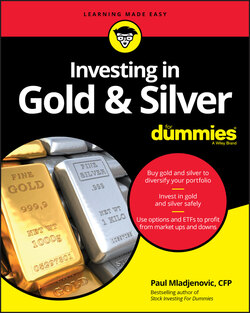Читать книгу Investing in Gold & Silver For Dummies - Paul Mladjenovic, Paul Mladjenovic, Ted Sudol - Страница 12
Understanding Gold and Silver’s Greatest Benefit
ОглавлениеIN THIS CHAPTER
Seeing how other investments stack up versus gold and silver
Realizing some major risks of gold and silver
As a certified financial planner (CFP) who teaches and consults on investing, I eat, sleep, and think about diversification all the time (it’s not as fun as it sounds!) because it’s always seen as a positive move for investors. Most financial advisors believe in diversification, but I take it to a level that many don’t. When financial advisors talk about diversification, it’s predominantly about “paper assets” such as stocks, bonds, exchange-traded funds (ETFs), mutual funds, and so on.
Yes, those advisors may also cover “hard assets” such as traditional real estate property and conventional assets such as personal holdings (jewelry, collectibles, and so on), but I’m an advocate for including hard assets such as gold and silver in the investor’s portfolio. And here’s the primary reason why.
Where possible, investors should have a variety of investment vehicles in their portfolio for obvious reasons. Diversification helps minimize risk as well as increase the chances of seeing your overall portfolio grow, and the time has come for investors to diversify with precious metals because the economic and financial environment for precious metals is better than ever. Gold and silver are an important part of your portfolio because they’re the only major assets on the financial landscape without counterparty risk. The bottom line is that gold and silver — hard assets used since the dawn of civilization — offer a unique quality of endurable value that paper assets don’t have.
All paper assets have counterparty risk, so what is it really? Here is the essence of this risk: A paper (or digital) investment asset only has value given the promise or performance of the counterparty involved. If the counterparty fails to perform, it will mean the decline of the value of the asset to the point that the asset can be worthless.
Because each class of paper assets has a different counterparty risk, I flesh out this foundational point in this chapter, and you’ll do an “Ooooh … I see what you mean!” (Flip to Chapter 4 for more information on other kinds of investment risks.)
